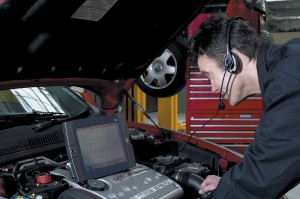
Electronic diagnostic tools for computerized cars are expensive and often specialized by brand.
More than 130,000 independent repair shops are bracing for the effects of the closings of thousands of Chrysler and General Motors new car dealers. A study by consulting firm Grant Thornton says that 20% of car dealerships in the United States are projected to close in 2009.
An unknown number of closed dealerships are likely to continue in the business of servicing vehicles and selling used cars, with a new concentration on repair work now that the factory-financed warranty claims will no longer provide a source of revenue.
It is very unfortunate that so many dealerships will be closing this year,” said Rich White, executive director, Car Care Council. “Because a vehicle is the second biggest investment for most car owners, they want it serviced by someone they trust. It makes sense to take the time to select a new auto repair facility that will take the best care of their investment.”
In general, the effect on the repair market for consumers should be positive, since competition — in theory — will bring down the price of repairs. At a minimum, ex-dealers will have the latest service equipment and the residual effects of factory training going for them. As electronics and onboard computers have completely taken over the monitoring and control of critical areas of a vehicle – brakes, tire pressure, steering, air bags, fuel delivery, ignition, oil change intervals, theft prevention, emission controls, among others – a shop with the latest technical knowledge can save you hundreds, if not thousands of dollars.
Countering this need for up-to-date information, is the widely held belief that dealers charge much more for repairs than independent shops, which is confirmed by surveys.”
As we last reported, on average dealership repairs cost 34% more than at independent shops. If you aren’t careful, you could end up paying too much for their services for equivalent work. This comes from a study from the Automotive Aftermarket Industry Association. It maintains that consumers paid $11.7 billion too much last year for parts and service. That’s a trend you don’t want to participate in.
Given such pricing disparities, it is not surprising that independent repair businesses account for more than 70% of vehicle service and repair, compared to 28% of non-warranty repairs by new car dealerships. Even before the accelerated dealership closings that started late last year, the number of dealerships and their share of the service and repair market have gradually declined each year since 2000, according to AAIA.
“There is a lot of confusion and anxiety among consumers these days about seeking quality service and repair for their vehicle,” said Kathleen Schmatz, AAIA president and CEO. “Vehicle owners need to look no further than their own community to find a reputable repair shop to care for their vehicle and protect the warranty.”
The Magnuson-Moss Warranty Act makes it illegal for a vehicle maker to void a vehicle warranty because routine maintenance was done by a non-dealer. However, you need to carefully document that you preformed the factory specified maintenance according to the required schedule in the owners manual, which means receipts and repair orders must be saved. If a warranty issue then arises, you have the documentation needed to ensure that your claim is not denied.
All automakers are cash starved these days, not just bankrupt ones, and there will be extreme pressure on their parts and service arms to generate profits from repairs to make up for lost vehicle sales revenue. This means you can expect strict interpretations of warranty terms, if not worse practices, on the shop floor.
As always it pays to shop around, since the cost of individual repairs varies widely. A radiator repair – parts and labor – for an import brand was 87% higher or $665 at a dealer compared to $311 at an independent. At the other end of the scale is a 15% difference for an air conditioning compressor – $933 dealer, $812 independent. This might reflect the fact that an independent might have to buy factory parts, as the dealer is required to do, if an aftermarket version isn’t available. The quality of aftermarket parts can also vary widely.
As for existing Chrysler and General Motors owners, both companies will continue to honor warrantees. Their remaining dealers continue to have access to replacement parts. And dealership service technicians will continue to be factory trained. In the case of discontinued brands such as Pontiac, GM says other brand dealers will pick up the service and warranty work.
